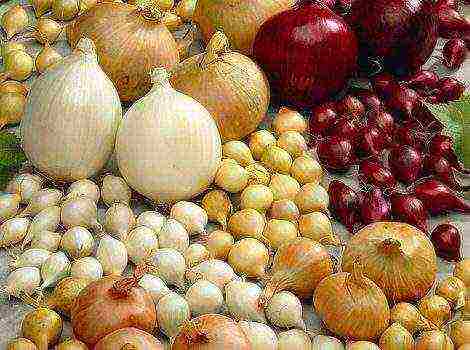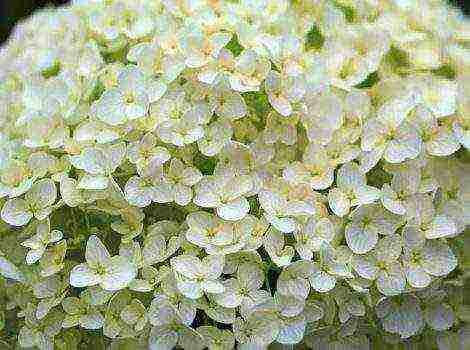Content [show]
Of the large number of ornamental plants that modern gardeners grow, garden camellia stands out for its delicate flowers and evergreen waxy leaves.
The plant cannot be called unpretentious.
To achieve a good result, the correct planting and care of the garden camellia must be organized.
Preparing for planting garden camellia
The preparatory work prior to planting a plant in the garden includes the correct choice of a place for its further growth, an appropriately prepared soil and healthy seedlings. Winter-hardy varieties are suitable for growing outdoors in the Moscow region.
Choosing a place on the site
The right location of the camellia will guarantee its growth and lush flowering. Bright sunlight is unpleasant for this plant. It should penetrate to the flower through the lace of the branches, illuminate well, but not burn.
The eastern or western part of the garden will be convenient. When located on the south side, the camellia is planted among trees and bushes, in their light shade.
The danger is posed by strong wind and draft acting on the camellia bushes. It is necessary to provide protection against such influences. It is unacceptable to plant a flower in places with close occurrence and stagnation of water.
This causes root rot and the plant dies. Camellia is planted on small elevations so that the roots do not get wet.
It is convenient to plant the plant along the fence of the site or at the eastern or western wall of the house. It is appropriate to plant a climbing curly camellia here. She will gracefully decorate even an unsightly fence, decorate a gazebo or a terrace.
Soil preparation
Camellias need acidic soil. When preparing a site for its landing, this must be taken into account. For planting flowers in containers, use soil purchased in specialized stores.
Suitable for azaleas and rhododendrons.
The best would be a composition of equal parts:
- high-moor peat;
- humus;
- coniferous land;
- sand;
- vermiculite or perlite.
When planting in the ground, you need to provide the same soil. For drainage, expanded clay and fine gravel are added to the garden bed. They monitor the acidity of the soil. For acidification, the bush is mulched with a pine or spruce needle or crushed bark of these trees.
Selection and preparation of planting material
When buying planting material, the following conditions should be observed:
- Purchase seedlings in specialized nurseries and garden centers. The cultivation of the plant should be carried out by specialists.
- The selected material should be 4 years old and have lignified shoots.
- Choose varieties that are suitable for growing in your climate.For the middle lane, winter-hardy varieties are chosen, if you do not plan to transplant the flower into pots for the winter and move it indoors.
- Carry out an external examination of the seedling. There should be no signs of disease on it, the leaves are clean and green. When buying a potted plant, make sure that the root system surrounds its entire volume.
Technology of planting garden camellia in open ground
The flower is planted in open ground from April to mid-June. By the onset of cold weather, the plant will gain strength and take root well.
Dig planting holes in the prepared bed. Their volume should be twice the volume of an earthen coma with plant roots. At the bottom we lay a drainage layer of expanded clay or fine gravel 20 cm thick.
Next, we fill in a pile of earth of the required composition. We place a seedling on it, carefully straighten the roots and sprinkle it with a layer of earth. The root collar of the seedling should not be covered with soil.
We compact the soil near the trunk and water it with water. We mulch with peat.
Garden camellia care
Planting and caring for a garden camellia must be carried out in compliance with certain rules. Let's consider them in more detail.
Watering rules
The plant needs regular watering. This is especially important in summer, in dry and hot weather. You don't need to keep the soil constantly moist. In extreme heat, camellia is sprayed.
This must be done with care so that no water droplets fall on the flowers.
Water for irrigation is not used hard, well-settled. It is useful to combine watering with top dressing. To do this, use a weak fertilizer solution.
If the plant is transplanted into a container for wintering and stored in a cool room, care must be taken that the soil does not dry out. Watering is not needed often, but it is still necessary.
Loosening and mulching
Loosening is carried out after watering, this helps to avoid the formation of a soil crust. So that the earth does not dry out in summer, it is useful to mulch it with cut grass, humus, bark or sawdust.
These materials increase the acidity of the soil, which is very beneficial for the plant. In any case, the root collar must be open so that it does not rot.
Selection and timing of fertilization
Camellia has a good root system that effectively absorbs nutrients from the soil. This crop requires a minimum amount of fertilizer.
Overfeeding will do the flower more harm than good. Before feeding, be sure to water the soil with water.
It is necessary to fertilize in April, when the plant begins to grow rapidly and new shoots are formed. For this, a complex composition of nitrogen, phosphorus, potassium, sulfur is used.
Moreover, the solution should be prepared twice as weak as indicated in the instructions for the composition. A good feeding would be an infusion of chicken manure. Formulations designed for rhododendrons and azaleas are suitable.
Fertilize the plant twice a month until the end of summer. In the fall, top dressing is unacceptable. Enhanced nutrition will cause vigorous growth of shoots. They will not have time to woody before the onset of cold weather and will die off. A young plant may freeze.
Pruning
Cut camellias for crown formation, better branching and a beautiful shape. This is done in the spring, pinching the tops of the shoots.
To stimulate the growth of axillary buds, autumn pruning of shoots is performed. This allows you to get a beautiful ornamental shrub.
Along with bush varieties, tree-like camellias are also used. The beautiful tree reaches a height of 15 m. Pruning for these varieties is done in a similar way.
Pruning can be done after the flowering period is over. Do not prune the plant too hard. This will weaken him and it will take more care.
"Particular attention should be paid to trimming the curly camellia."
Another important point when caring for camellia is its transplant. An indoor flower needs to move from pot to pot every two years. When growing in a garden, this condition is optional.
The plant should be transplanted if it shows weak growth and flowering, perhaps you have chosen the wrong place for it. The transplant is carried out during the resting period of the plant. The best time will be late autumn before the onset of frost.
Preparing for winter
In the southern regions, camellia can easily winter in the ground without shelter. Even blooming in winter is possible. The middle lane and Siberia will require more careful plant care.
Some gardeners transplant the flower into containers and transfer it to winter indoors or in a warm greenhouse.
An insulated balcony or terrace is suitable for the winter existence of a camellia. Daytime temperature should not exceed + 120C, and at night it should vary from 0 to 50C.
Under such conditions, camellia can please with flowering, which looks very beautiful in a snowy and frosty winter.
If you leave the plant for the winter in the ground, you should take care of the shelter. If it is not possible to observe the camellia constantly, mulch the soil around the bush with peat, bark or leaves.
In winter, covered with snow, it will be well preserved and will decorate the garden with a green oasis. In the case of a winter with little snow, it is necessary to provide additional cover with lutrasil or dry grass.
Diseases and pests
Disease is easier to prevent than to cure, so pay close attention to your exotic flower. At the first manifestations of the disease or harmful insects, treatment should be carried out and the damaged parts of the plant should be removed.
Among pests, camellia is besieged:
Aphid. Small insects stick around shoots and leaves, which dry out from this. With a large number of aphids, the plant may die completely. There are various ways to remove the pest.
The easiest one is to wash it off with soapy water. It should be fed to the plant under pressure. You can use a biological solution of fitoverm.
Spider mite. Covers the plant with cobwebs containing small larvae. They damage the leaves, causing them to dry out. The tick multiplies quickly, and if you do not get rid of it in time, the plant will die.
It is preferable to use biological preparations phytoverm, bicol, bitoxybacil, created on the basis of bacteria and microorganisms that are not dangerous to humans, to combat ticks.
It is possible to use acarin. It is a fast-acting, low-toxicity chemical.
An unpleasant phenomenon when growing in a garden for camellia can be the appearance of various fungi on the leaves and shoots. It is difficult to deal with them. To prevent diseases, it is necessary not to overmoisten the soil and provide ventilation of the bushes.
With the onset of winter, it is good to treat the camellia with copper sulfate, Bordeaux mixture, and Saporol.
Reproduction of camellia garden
Camellia breeding methods are no different from those for other horticultural crops. Flower cultivation is possible:
- seeds;
- cuttings;
- layering;
- vaccinations.
Let's consider the most commonly used ones.
By cuttings
In early August, half-lignified shoots are cut from the bush. The stalk should be no more than 8 cm long and have five leaves. In the future, the shoot needs to be rooted.
For this, a substrate is prepared, consisting of a mixture of peat and sand in equal proportions. Rooting is best done in separate pots.
The soil is well moisturized. It is useful to dip the tip of the cutting into phytohormone. The required soil temperature is 25 ° C. Cover the planting with a transparent container to create a greenhouse effect and facilitate the formation of roots.
After two months, the shelter is carefully removed and they continue to care for the camellia as a house plant.
Seed
Camellia seeds ripen in mid-October. They immediately begin to plant them.
You should know! "That camellia seeds contain a lot of essential oils, which is why they take a long time to germinate."
For sowing seeds, use wooden boxes filled with a mixture of peat and sand. Peat creates the necessary acidic environment, and sand provides soil looseness and drainage.
For active germination of seeds and their further growth, it is necessary to maintain a room temperature of 20 ° C. This process lasts for a year. Only after the appearance of two leaves, the seedlings are transplanted into separate pots, 7 cm in diameter.
Camellia seedlings obtained from seeds are much more resistant and adapt well to further growth. They bloom in the fifth year, but there have been cases of earlier flowering - after three years.
Frost-resistant varieties of camellia
A very beautiful exotic flower could not fail to attract the attention of breeders. Varieties have been created that can withstand winter frosts down to -20 ° C when growing flowers in the open field.
Consider the best frost-resistant camellia varieties. They begin to bloom in early spring and retain their green leaves in winter frosts.
Donation is an ornamental shrub with fragile delicate pink purple flowers. The rounded shape of the petals is reminiscent of orchids.
The bush grows slowly, but allows slight flaws when growing. Even an inexperienced gardener can take care of him. The bush has a lush dark green crown, covered with large bright flowers.
Debbie camellia bears deep purple-pink flowers. The shrub grows rapidly and blooms profusely. It has double, rounded petals similar to Donation flowers.
The plant of this variety is resistant to the surrounding climate, not afraid of precipitation and frost in late spring. Suitable for people who first encountered such a plant.
Japanese breeders' variety Hagoromo blooms with pearl pink buds. These flowers are chameleons. As they bloom more and more, they turn white. A beautiful and delicate flower.
FreedomBell bears flowers of a coral red shade with an overflow, decorated with bright stamens. It has large decorative glossy leaves. This variety tolerates pruning well, shoots can be greatly shortened when freezing.
Any type of garden camellia, whether it is a bush, tree variety or climbing liana, will become a decoration of the home garden. This gorgeous plant is a winning accent in any landscape design.
Camellia is called "the empress of garden flowers" for a reason. You can create a secluded gazebo entwined with a climbing camellia. The bushes planted along the fence form a natural hedge.
A bush or gorgeous tree will create a striking accent in the lawn. In winter, on the white snow, the bright greens of the evergreen shrub will look fabulous and unique.
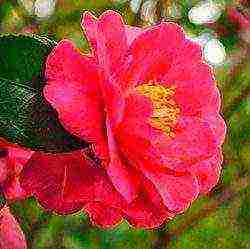 Her garden camellia is compared to a rose, balsam and even ranunculus. Yes, they are similar, but this plant is a shrub that blooms all season and does not shed its foliage for the winter. It is these qualities that are loved by flower growers who are growing a flower on their site. Want to try? It is necessary to study the features of planting and the basics of care, because the agricultural technology of growing camellia is different from the agricultural technology of growing other crops. Choose a variety from the photo, and make out the front garden!
Her garden camellia is compared to a rose, balsam and even ranunculus. Yes, they are similar, but this plant is a shrub that blooms all season and does not shed its foliage for the winter. It is these qualities that are loved by flower growers who are growing a flower on their site. Want to try? It is necessary to study the features of planting and the basics of care, because the agricultural technology of growing camellia is different from the agricultural technology of growing other crops. Choose a variety from the photo, and make out the front garden!
Description of garden camellia: species and varieties obtained from them
Camellia came to Europe from China, Korea and Japan, where this flower is deified, attributing healing properties to it. In the wild, it grows on the edges of the forest, near water bodies, therefore it is picky about watering and loves diffused light.
There are 3 types of garden camellia:
- oilseed, a feature of which is autumn flowering and a height of up to 10 m. A real tree !;
- mountain, which is a spreading bush with simple flowers. Height - up to 5 m;
- Japanese, characterized by large flowers (there are double options), rich dark foliage and compact bush.
It was from the Japanese camellia that many hybrid varieties were created that are used by flower growers. Their advantage is a long flowering period, frost resistance and a variety of flowers (in bud shape, size and color). Attention can be paid to the varieties:
- General Colletti - deep scarlet double flowers with white streaks;

General Colletti
- Freedom Bell is an upright shrub with excellent pruning tolerance. Feature - coral flowers;
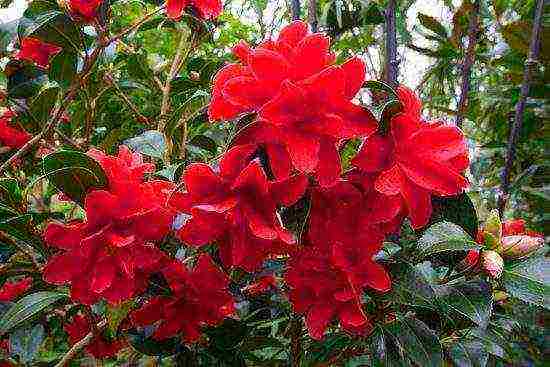
Freedom bell
- Hagoromo is a low-growing bush (up to 1.5 m) with milky flowers. Attracts with sophistication and nobility.

Hagoromo
Interesting! Do you love delicious and aromatic tea? Not only dried leaves, but also camellia flowers are perfect for this. Add a little mint, linden - and you get such an exotic composition!
Reproduction and planting of camellia, or nothing is impossible
Having decided to decorate your own plot with an exotic shrub, you need to purchase a bush in a container or grow it yourself. This is a task that even a novice florist can handle.
Shrub propagation: simple ways
In order to get a camellia, you must either buy or ask a neighbor for several young shoots. Camellia reproduces in 2 ways:
- Seeds. This method is laborious, and the plants lose their varietal characteristics. But for the sake of experiment, you can try. To do this, the seeds must be laid out in pots 5-7 cm in diameter (substrate - peat + sand + humus), take care of watering, sufficient light and humidity. In the phase of 4 true leaves, transplant into a large container.
- Cuttings. They are cut from green young shoots (only the tops!), Rooted in the standard way. When the plant grows, they are transplanted into containers with a capacity of 2-3 liters.
Attention! Young plants obtained by any of the methods must be grown for 4 years. For this, the temperature in the room during the winter period should not fall below 8-10ºC.
Planting camellia: features
So you got the plant. It is necessary to give it life, that is, to land it in open ground. And then do not forget about watering, lighting and feeding.
In order to plant a camellia beauty, you must:
- pick up a place. The best option is a well-lit area (but the one where half the day is sun, half is shade is quite suitable), sheltered from the winds, that is, the area near the fence or MAF;
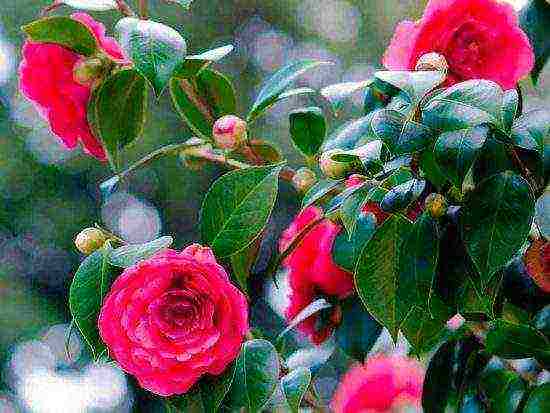
Camellia responds well to mulching
- pay attention to the soil. Garden camellia, unlike many other residents of the site, prefers acidic soils. This can be achieved by applying special organic and mineral fertilizers;
- dig a hole, which will be 2 times larger than the earthen lump of the plant. Camellia roots are fragile and delicate, so planting should be done carefully. With proper care, the bush will grow in 14-21 days;
- water the plant after planting and mulch with humus, sawdust or straw. This will give the roots the necessary moisture and protect the soil from weathering;
- shade from direct sunlight in the first week of growth.
It remains to provide the shrub with proper care and enjoy a healthy plant!
Camellia care: TOP-5 rules
Camellia care is watering, fertilizing, protection from pests and diseases. But each of the points has its own characteristics. Here is general information and specific points. They are as follows:
- Fresh air, but no wind. It is better to save the bush and protect it by planting powerful trees nearby.
- Bright light, but it is not direct sunlight, but scattered light. You can stretch a special shading net over young plants.
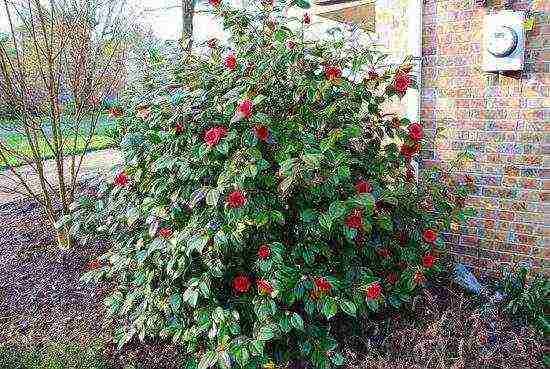
Camellia bush
- Watering. Uniform and regular - that's what the overseas beauty wants. An excellent solution for maintaining the health of camellia is to spray the leaves with settled warm water.
- Pruning and sheltering for the winter. The first, which can be carried out both in spring and autumn, will help form a compact and interesting bush; the second is to protect the plant from freezing in the absence of snow and the presence of frosty winds.
- Top dressing with mineral and organic fertilizers. Camellia, in return, will delight you with amicable and abundant flowering throughout the season.
Pest / disease preparations "plus" feeding: on the way to a healthy shrub
This is not to say that camellia is too susceptible to disease. The only ones are fungal, which can be seen on the leaves: they turn yellow, turn brown, dry and fall off. Any fungicide for flowers purchased from a specialized store will help here.
Pests rarely disturb the shrub, but spider mites and even aphids can be seen during dry periods. In the fight against them will help drugs "Akarin", "Fitoverm" and the like.
However, the best remedy for pests and diseases is prevention, which includes not only proper care of the plant, but also feeding. The flower will be grateful for fertilizers that acidify the soil. An excellent solution can be those fertilizers that are for rhododendron.
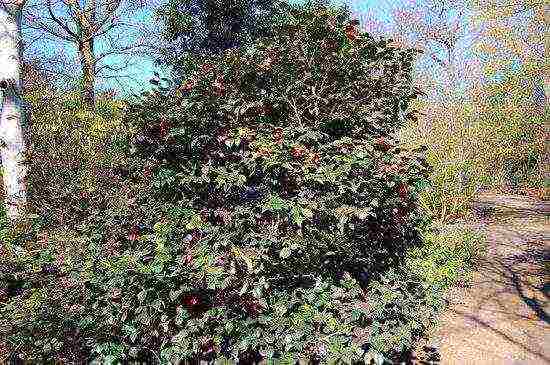
Camellia goes well with other plants in the garden
Combinations with other plants, or flawless landscaping
Camellia will look great with any flowers, shrubs and even trees in the garden, harmonizing with the rich green shade of the foliage and striking the beauty of large flowers when flowering is no longer typical for many. The only condition is soil acidity, which is difficult to achieve in mass plantings.
The solution is in growing camellia in a tub, which can not only be placed anywhere in the garden, but also brought into the room during frosts, for example. However, in this case, it is worth feeding the plant more often and monitoring the condition of the foliage.
Camellia, decorating your territory, will appeal to everyone, both guests and households. All that remains is to install a swing nearby and enjoy the beauty and aroma of flowers!
How to grow camellia: video
 For garden camellias, a comparison was stuck with roses, but only blooming, when all the plants are at rest, in winter. But the similarity of cultures is limited only by the splendor and shape of the flowers, the care and cultivation of camellia in the garden is strikingly different from the agricultural technology of other ornamental shrubs.
For garden camellias, a comparison was stuck with roses, but only blooming, when all the plants are at rest, in winter. But the similarity of cultures is limited only by the splendor and shape of the flowers, the care and cultivation of camellia in the garden is strikingly different from the agricultural technology of other ornamental shrubs.
The reason for the uniqueness of camellias is in the peculiarities of their growth in the wild in the regions native to plants. In the humid, close to subtropical climate of the southeast of Asia, flowering shrubs and small camellia trees have been used for many centuries for landscaping park and palace complexes.
In moderately hot summers and winters with small subzero temperatures, the culture feels great in the open field. But is it possible to grow and care for a garden camellia on the street in Russian conditions?
The history of growing and caring for camellia in the garden
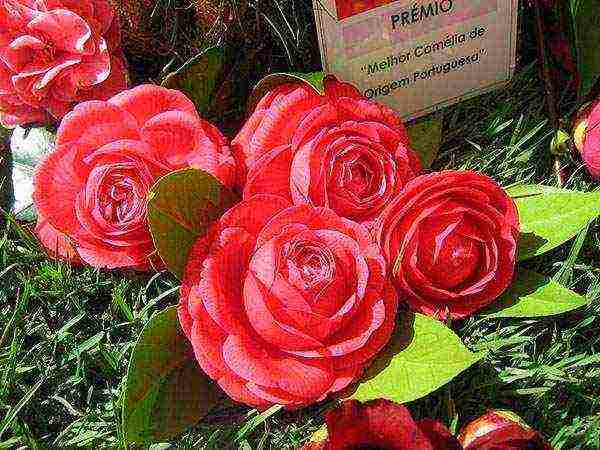 In Europe, the first specimens of camellias appeared in the first half of the 18th century. Over the years, gardeners have learned to care for the crop, numerous varieties and hybrids have appeared:
In Europe, the first specimens of camellias appeared in the first half of the 18th century. Over the years, gardeners have learned to care for the crop, numerous varieties and hybrids have appeared:
- which have become more resistant to frost than wild species;
- with a longer flowering period;
- with rims unique in shape, size and variety of colors.
The oldest specimens of camellias, once exported from Japan and China, can still be seen in the greenhouses of Britain, in the garden of the old royal residence in Dresden and in the parks of Spain.
And at the disposal of modern lovers of flowering shrubs, garden camellias, as in the photo, with flowers resembling peonies, roses of various types and even anemones. Among the camellias there are trees and shrub forms.
Plants are able to withstand significant cold, but camellias are unlikely to survive at temperatures below –20 ° C. The most winter-hardy varieties are considered today: Donation, Jury's Yellow, Debbie, Hagoromo. The flowering of these varieties is delayed until spring, but in winter they retain their bright green foliage.
Conditions for the care and cultivation of garden camellia
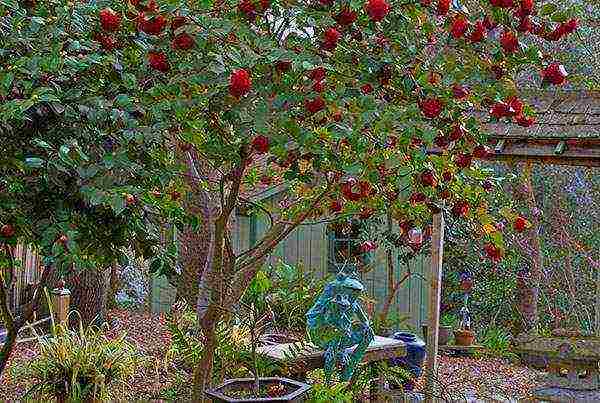 But even such frost-resistant plants will not be able to withstand the cold weather in the middle zone of the country. Therefore, here garden camellias are grown in large containers, for the winter they are brought into a cool room, on a terrace or in a greenhouse.
But even such frost-resistant plants will not be able to withstand the cold weather in the middle zone of the country. Therefore, here garden camellias are grown in large containers, for the winter they are brought into a cool room, on a terrace or in a greenhouse.
Camellia does well in pots at temperatures of 10-15 ° C.If the plant is provided with good, but diffused lighting for 12-14 hours a day, then caring for the camellia when growing in the garden will not be difficult. The shrub will pick up color in time and will delight the gardener with an abundance of wonderful flowers.
In regions with milder winters, evergreen bushes are covered, and in the subtropical zone, garden camellias, as in the photo, from February to mid-spring are covered with many spectacular flowers up to 10 cm in diameter.
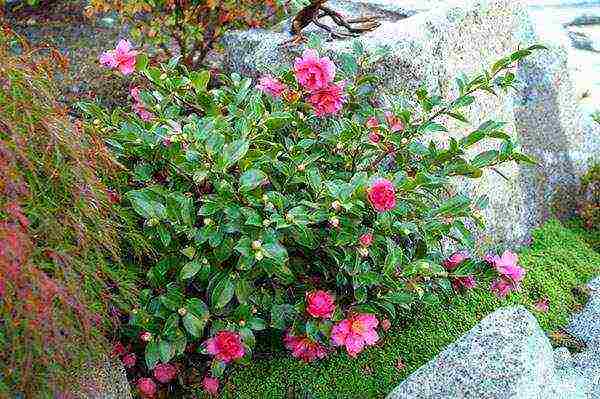 Camellias blooming in the garden can suffer not only from frost, but also from the bright winter sun, which manifests its activity in the morning hours.
Camellias blooming in the garden can suffer not only from frost, but also from the bright winter sun, which manifests its activity in the morning hours.
To prevent foliage and flower petals from turning black and not dying, thawing after the night, it is better to shade the plants or cover them with non-woven material at night. The same measure will help preserve shrubs if cold winter winds are frequent on the site.
Since garden camellias, in the photo, tolerate partial shade well, the crowns of garden trees can protect them from the negative effects of the environment. When choosing neighbors for an ornamental culture, it is only important to take into account that camellias love acidic soil, which not all garden dwellers like.
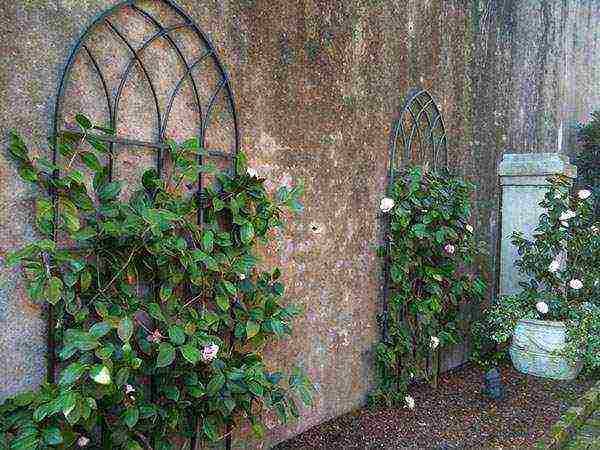 Camellias grow well under the shelter of fences, near the walls of houses and outbuildings. With the help of supports and trellises, gardeners successfully grow a climbing camellia in the garden, which, with the help of painstaking shaping, is given a flat vertical shape.
Camellias grow well under the shelter of fences, near the walls of houses and outbuildings. With the help of supports and trellises, gardeners successfully grow a climbing camellia in the garden, which, with the help of painstaking shaping, is given a flat vertical shape.
Planting and caring for garden camellia
In addition to knowing the right place to plant a garden camellia and caring for it, the gardener must understand the plant's requirements for soil, watering and feeding. But the life of a culture in the open field begins with the planting of shrubs.
 The planting hole for the garden camellia is made twice as wide and deeper than the earthen lump of the seedling. This is done so that the plant immediately falls into the nutritious enough acidic soil, which is necessary for the capricious beauty for growth and flowering.
The planting hole for the garden camellia is made twice as wide and deeper than the earthen lump of the seedling. This is done so that the plant immediately falls into the nutritious enough acidic soil, which is necessary for the capricious beauty for growth and flowering.
The soil for the garden camellia, in the photo, consists of equal shares of humus, coniferous soil, high peat and sand. To acidify the soil, chopped spruce or pine bark can be added to the substrate. The selected mixture should be loose, light and structured. In such a soil, the roots of camellia:
- get the required amount of air and moisture:
- will not be at risk of decay;
- will actively grow, helping to get nutrition for the aboveground part of the bush.
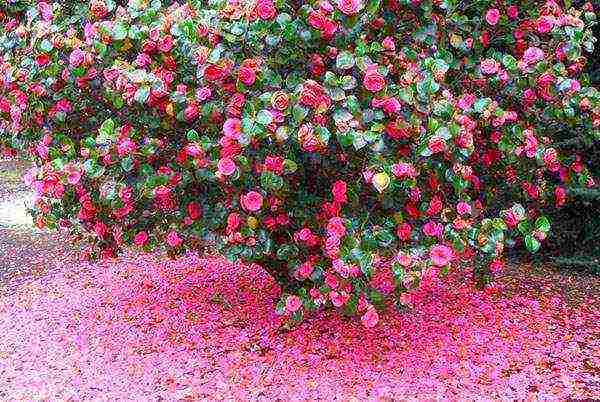 A drainage layer is made at the bottom of the pit, prepared soil is poured over it so that after filling the coma placed on the bottom, the root collar of the bush does not end up under the soil layer. In this case, planting a camellia for care in the garden is carried out correctly. The surface of the soil is mulched with needles, sawdust, shavings or bark in order to:
A drainage layer is made at the bottom of the pit, prepared soil is poured over it so that after filling the coma placed on the bottom, the root collar of the bush does not end up under the soil layer. In this case, planting a camellia for care in the garden is carried out correctly. The surface of the soil is mulched with needles, sawdust, shavings or bark in order to:
- prevent moisture evaporation;
- gradually replenish the acidity of the substrate.
By autumn, the layer of mulch is increased, carefully covering the base of the camellia. Such a measure will help to avoid damage to the bush from frost spreading over the soil and lack of snow at the beginning of winter.
To simplify the care of the garden camellia, planting is carried out in late autumn or at the end of winter, when the plant has not yet begun to actively grow shoots. In this case, the shrub acclimatizes well and quickly begins to grow, perceiving both watering and fertilization.
Watering and feeding camellia when leaving and planting in the garden
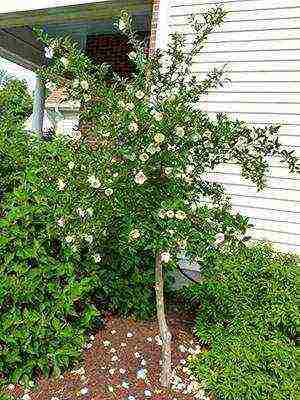 Top dressing of garden camellia is carried out from spring to the end of July. The shrub accepts well the introduction of complex additives, which can be replaced with a one-time feeding with granulated bird droppings at the beginning of summer.
Top dressing of garden camellia is carried out from spring to the end of July. The shrub accepts well the introduction of complex additives, which can be replaced with a one-time feeding with granulated bird droppings at the beginning of summer.
The plant, like other garden dwellers, needs water. The most abundant and frequent watering is in spring and summer, but since autumn, together with a restriction in fertilizers, they reduce soil moisture. This measure of care when growing camellia in the garden stimulates the appearance of buds.
So that all the efforts spent on planting and caring for the camellia in the garden are not in vain, when buying planting material, it is important to make sure that the selected variety is able to survive in winter conditions in the open field. If in doubt, it is more reasonable to choose a suitable container for the seedling and grow the camellia as a pot culture, which will have to be transferred to a cool room for the winter.
Festive flowering camellia - video
Common in the southern tropics from Japan to the Philippines, camellia rules the evergreen forests in southern Russia. Gorgeous and sophisticated, she can not help but please. Its flowers, vaguely reminiscent of roses, amaze the imagination with their regal beauty. Camellia, a very demanding culture, to grow it in a summer cottage will require some knowledge, but responsive to care and feeding, the princess will reward with a long festive fireworks of flowers. Giving luxurious flowers, garden camellia needs care and attention.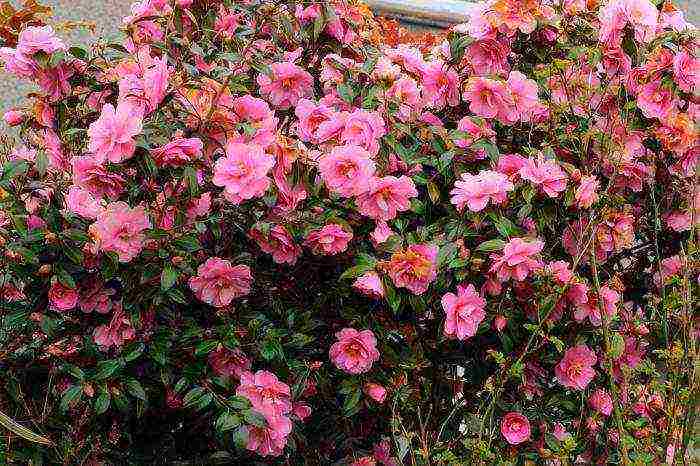
Evergreen camellia: description
The genus camellia of the tea family has up to 80 varieties, which are evergreen shrubs or trees. The decoration of the shrub is the leaves - glossy, leathery oval, pointed single or accrete at the base, as well as flowers of all shades of white-pink-lilac. Many species are widespread due to their high decorative qualities. Garden camellia blooms in winter, when the thermometer does not exceed 12 ° C. The duration of flowering of the shrub is also surprising. It is from 1 to 3 months. Each flower is capable of not fading for about a month. On this amazing shrub, flowers appear in the winter at the ends of the shoots. The blooming garden camellia, the photo of which is presented, is a festive and solemn sight. She is able to radically change any, even the most dull and unpromising area. That is why, among landscape designers, camellia is on a high pedestal. These magnificent shrubs are invaluable in landscaping interiors, creating park and garden compositions. The most interesting object in creating landscape masterpieces is the Japanese garden camellia - an evergreen tree or shrub that reaches 10-15 m in height, common in the subtropical forests of Japan and China. A distinctive feature of the Japanese camellia is the presence of large red single flowers located in the axils and at the tops of the branches. Flowering is spectacular and long lasting. In culture, there are up to 1000 different garden forms and varieties with a wide variety of double and semi-double flowers with a diameter of 4 to 15 cm. Japanese camellia is photophilous, but it also tolerates slight shading.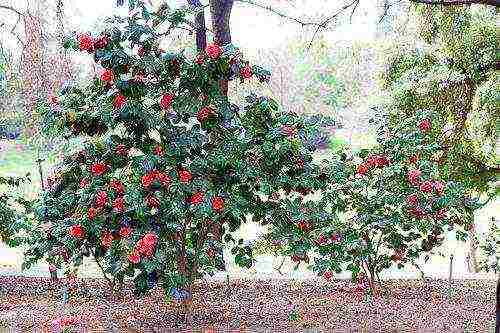
Garden camellia: planting and care
The easiest way to propagate camellia is by seed. Usually freshly harvested seeds are sown, the germination rate of which is 80-90%. They are not stored, as they rapidly lose their ability to germinate. The ideal soil for sowing is a mixture of river sand and peat in equal proportions. To accelerate seed germination, the air in the room where the seedlings are grown is warmed up to + 22 ° C. Seedlings germinate and take root throughout the year. It should be remembered that the young seedlings obtained are distinguished by a low level of resistance to adverse influences, however, with high-quality care, they develop intensively, increasing the degree of winter hardiness, which the garden camellia differs. Care and cultivation ends with flowering, which usually occurs in the fifth or seventh year, sometimes after 2-3 years.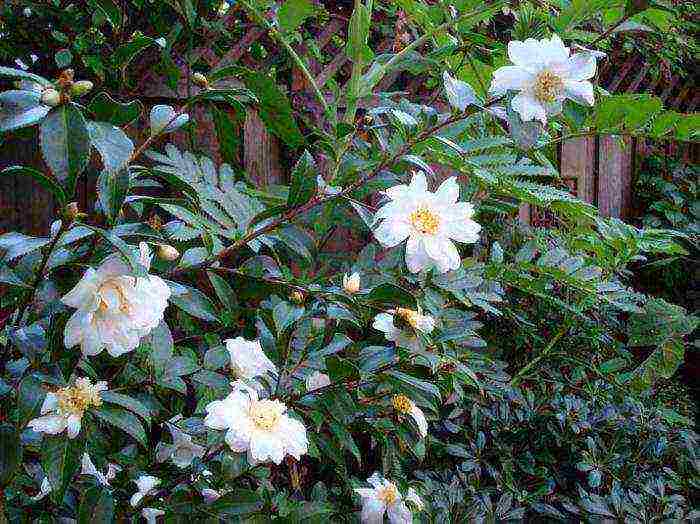
Propagation by cuttings
For propagation of varietal camellias, the vegetative method is more suitable - with apical cuttings, for which shoots of the current year with two or three internodes with developed axillary and apical buds are chosen. The sizes of cuttings are purely individual, ranging from 3 to 12 cm and depend on the variety of camellia. They are cut in July or August.From the bottom of the cutting under the axillary bud, the most oblique cut is made, the bottom sheet is also cut off. To increase the likelihood of rooting, the cuttings are placed in a solution of stimulants for 5 - 7 hours and planted in clean river sand, covered with glass or film. An important condition for rooting is maintaining a constant temperature in the region of 23-27 ° C. Rooting takes a long time - up to one and a half to two months. Treatment with a stimulant significantly increases the rooting rate and forms a powerful root system of the plant.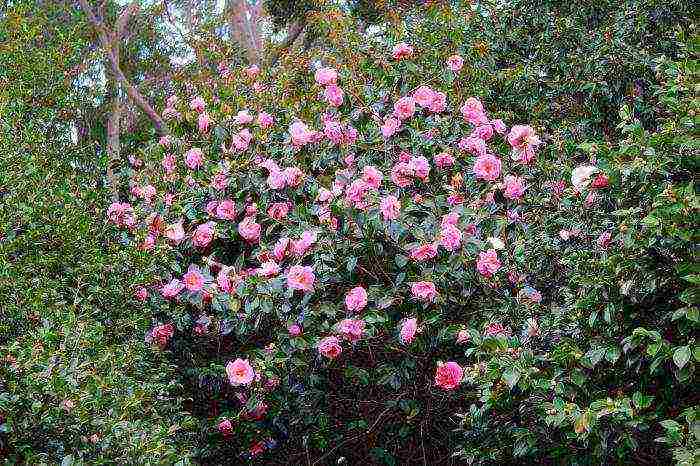
Preparing the soil for planting in a permanent place
Garden camellia is a lover of acidic soils. Fertile and permeable soils are especially suitable for planting this shrub. When planting, it is important to remember: the camellia should not be buried too deep, its root collar should be flush with the ground. Once a year, the shrub needs feeding. Organic matter is considered the best fertilizer for camellia. At the end of summer, when the plant begins to form buds for flowering next year, the camellia is fertilized with humus, chicken droppings. There is no need to feed the shrub later, as the buds may fall off. A necessary condition for the good development of a plant is mulching with leaf humus, grass, crushed bark or chips, that is, everything that ensures the preservation of soil acidity and moisture at the roots. When mulching, it is necessary to leave the root collar open, as otherwise the camellia can rot.
Watering
Good development, which is a consequence of proper cultivation, will be appreciated by the garden camellia. Planting and care, as well as competent watering, contribute to
rapid plant growth. Regular watering should be provided in all seasons. In the summer they water more generously, taking into account the weather conditions and the landing site. If the summer is hot and dry, it is necessary to spray the bush. In cooler winters, watering is more careful and infrequent.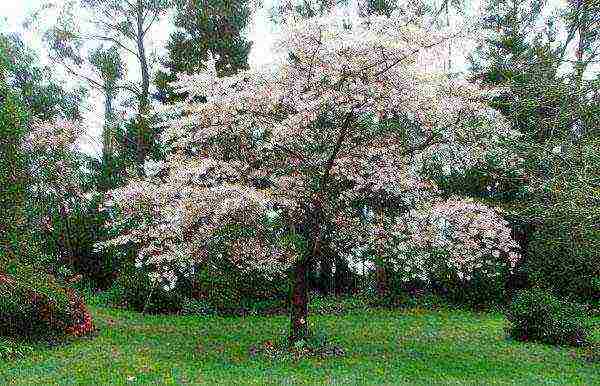
Camellia care
Camellias thrive in humid and temperate climates. They are quite winter-hardy and can withstand frosts down to -20 ° C, prefer shade, and in areas with dry hot summers - a shady location. Camellias are especially fond of being located next to a fence, wall or other higher culture, that is, a support that protects from the winds and the bright sun. The flowering time of the plant is unusual: autumn - winter - early spring. These are the biological features of this genus: for the formation of high-quality buds and flowering shrubs, a short daylight hours and coolness are required. Comfortable air temperature for setting flower buds is 18-20 ° C, for flowering - 8-12 ° C. Camellias love diffused light, but not direct bright sunlight. Blooming representatives of the tea family they are not afraid of night frosts, but when the flowers quickly thaw in the morning sun, they lose their appearance and die. Therefore, camellias are usually not planted on eastern slopes.
Pruning
Form the crown of the camellia in the spring, pinching the tops of the shoots. This is done in order for the garden camellia to branch better. Planting and caring for bushes is not a complicated operation. In late autumn, shoot pruning is required to stimulate axillary bud growth. Repeating this operation annually, you can achieve excellent decorative effect and flowering of the bush.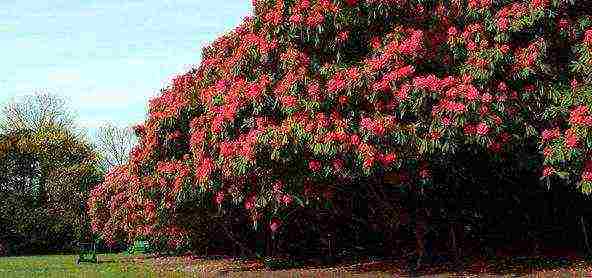
Pests and diseases
Unfortunately, pests and diseases do not bypass camellias. It is often attacked by fungi, aphids and worms. Fungal diseases are manifested by the appearance of gray and black spots on the leaves and brown spots on the flowers. A diseased plant cannot be restored, so it is better to remove and burn it.
Insect pests feed on plant juices, causing it to rot. To get rid of parasites, you should wipe the affected leaves and stems with an alcohol solution with further treatment of the camellia with insecticides.
The garden camellia, amazing in beauty and duration of flowering, gives incredible joy. Planting and caring for this culture is not as burdensome as they write in many publications, but it is impossible to contain emotions, looking at the regal decoration of a magnificent tree.

